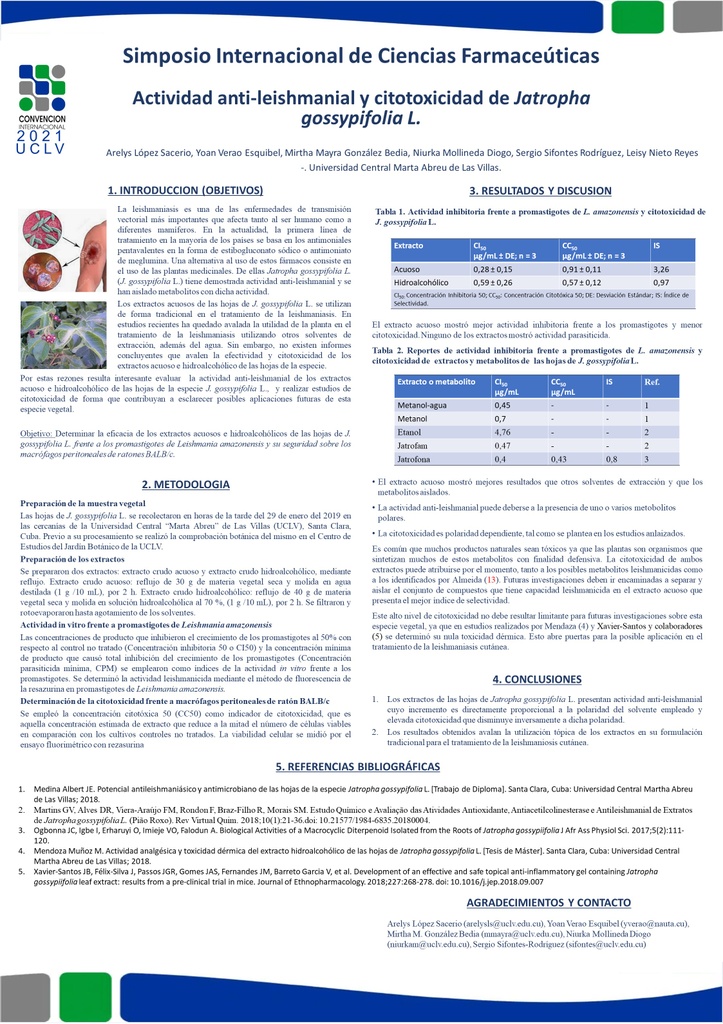Executive Secretary

Simposio Internacional de Ciencias Farmaceúticas
SICF

Abstract
Introduction: Aqueous extracts of the leaves of Jatropha gossypifolia L. are traditionally used in the treatment of leishmaniasis. In recent studies the utility of the plant in the treatment of leishmaniasis has been supported. Although, There are not conclusive reports related to their effectiveness and cytotoxicity.
Method: The antileishmanial activity and the cytotoxicity of the aqueous and hydroalcoholic extracts of the leaves of Jatropha gossypifolia L. were determined using the resazurine fluorescence method. Both, promastigotes of Leishmania amazonensis and peritoneal macrophages of Balb/c mouse were studied.
Results: The half-maximal inhibitory concentration for the aqueous and hydroalcoholic extracts were 0,28 µg/mL ± 0,15 µg/mL (n=3) and 0,59 µg/mL ± 0,26 µg/mL (n=3) respectively, although they did not show parasiticide activity at any of the evaluated concentrations. Similarly, the mean cytotoxic concentrations obtained were 0,91 µg/mL ± 0,11 µg/mL (n=3) and 0.57 µg/mL ± 0,12 µg/ml (n=3).
Conclusions: The aqueous extract was more effective and less cytotoxic against Leishmania amazonensis promastigotes. The results obtained support the traditional use of the extracts by topical application in the treatment of cutaneous leishmaniasis.
Resumen
Introducción: Los extractos acuosos de las hojas de Jatropha gossypifolia L. se utilizan tradicionalmente en el tratamiento de la leishmaniasis. En estudios recientes ha quedado avalada la utilidad de la especie en el tratamiento de la leishmaniasis. Sin embargo, no existen informes concluyentes sobre su efectividad y citotoxicidad.
Método: Se determinó la actividad leishmanicida y la citotoxicidad de los extractos acuoso e hidroalcohólico de las hojas de Jatropha gossypifolia L. mediante el método de fluorescencia de la resazurina en promastigotes de Leishmania amazonensis y macrófagos peritoneales de ratón Balb/c, respectivamente.
Resultados: Se obtuvieron concentraciones inhibitorias 50 de 0,28 µg/mL ± 0,15 µg/mL (n=3) y 0,59 µg/mL ± 0,26 µg/mL (n=3) para el extracto acuoso e hidroalcohólico respectivamente; aunque no se presentó actividad parasiticida a ninguna de las concentraciones evaluadas. De igual manera las concentraciones citotóxicas 50 obtenidas fueron de 0,91 µg/mL ± 0,11 µg/mL (n=3) y 0,57 µg/mL ± 0,12 µg/ ml (n=3).
Conclusiones: El extracto acuoso resulta ser más eficaz y menos citotóxico frente a los promastigotes de Leishmania amazonensis. Estos resultados avalan la utilización tópica de los extractos en su formulación tradicional para el tratamiento de la leishmaniasis cutánea.
About The Speaker

MsC. Arelys López Sacerio

